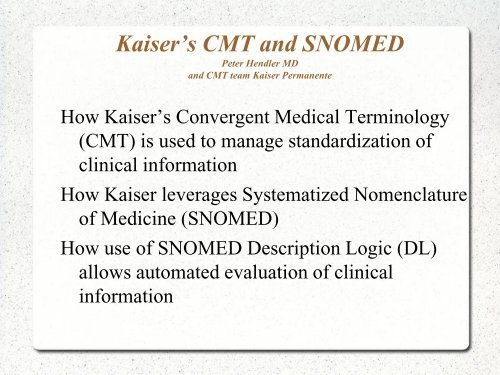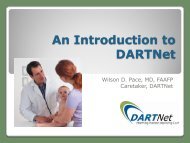Kaiser's CMT and SNOMED
Kaiser's CMT and SNOMED
Kaiser's CMT and SNOMED
You also want an ePaper? Increase the reach of your titles
YUMPU automatically turns print PDFs into web optimized ePapers that Google loves.
Kaiser’s <strong>CMT</strong> <strong>and</strong> <strong>SNOMED</strong><br />
Peter Hendler MD<br />
<strong>and</strong> <strong>CMT</strong> team Kaiser Permanente<br />
How Kaiser’s Convergent Medical Terminology<br />
(<strong>CMT</strong>) is used to manage st<strong>and</strong>ardization of<br />
clinical information<br />
How Kaiser leverages Systematized Nomenclature<br />
of Medicine (<strong>SNOMED</strong>)<br />
How use of <strong>SNOMED</strong> Description Logic (DL)<br />
allows automated evaluation of clinical<br />
information
Kaiser donates <strong>CMT</strong> to IHTSDO<br />
<strong>and</strong> to NLM<br />
Kaiser has agreed to donate <strong>CMT</strong> to the IHTSDO<br />
organization as well as NLM in the USA<br />
The donation will include Kaiser mappings<br />
between various terminologies<br />
It will include our modifications to the IHTSDO<br />
work bench<br />
This will greatly reduce the burden of adding<br />
<strong>SNOMED</strong> to an enterprise EHR
Domains covered by <strong>CMT</strong><br />
(1)<br />
• Diagnosis<br />
–Support Problem List, Encounter Diagnosis, <strong>and</strong> Medical History<br />
–Mapped to <strong>SNOMED</strong> <strong>and</strong> ICD9, <strong>and</strong> in the process of mapping to ICD10<br />
• Procedures (Medical, lab, radiology, etc.)<br />
–Supports Order Entry<br />
–Supports documentation of Performed Procedures<br />
–Mapped to <strong>SNOMED</strong> <strong>and</strong> CPT4 or HCPCS<br />
• Lab Results<br />
–Supports Results Review<br />
–Mapped to LOINC<br />
• Reasons for visits/Chief Complaints<br />
–Supports scheduling/intake<br />
–Mapped to <strong>SNOMED</strong><br />
• Immunizations<br />
–Supports Immunization/Vaccine Administration<br />
–Mapped to CVX codes (CDC’s Vaccine codes)
Domains covered by<br />
<strong>CMT</strong> (2)<br />
• Organisms<br />
–Supports Results Review<br />
–Mapped to <strong>SNOMED</strong> codes<br />
• Clinical Observations<br />
–Supports clinical assessment documentation<br />
–Mapped to <strong>SNOMED</strong> <strong>and</strong> Clinical LOINC (in process)<br />
• Nursing Documentation<br />
–Supports nursing documentation of nursing interventions <strong>and</strong> nursing assessments<br />
–Mapped to <strong>SNOMED</strong> <strong>and</strong> Clinical LOINC (in process)<br />
• Specimen Type <strong>and</strong> Body Site<br />
–Supports Order Entry for cultures<br />
–Mapped to <strong>SNOMED</strong><br />
• Allergens<br />
–Supports Allergy entry<br />
–Mapped to Medispan, FDB, <strong>and</strong> RxNorm (in process)<br />
•
Why “Enterprise<br />
Terminology”?<br />
• There is no one terminology that meets all needs.<br />
• St<strong>and</strong>ard terminologies were created to meet certain specific needs.<br />
• We have a need use all or most of the different terminologies.<br />
• We have a need to integrate or “converge” these disparate terminologies in a<br />
central model that leverages the efficiencies of each of these terminologies,<br />
provides interoperability, <strong>and</strong> meets other business requirements.<br />
• None of the st<strong>and</strong>ard terminologies are ever “complete”. Therefore, there is a<br />
need to create new concepts or enterprise specific concepts.<br />
• Turnaround time from reference terminologies is slow (i.e. <strong>SNOMED</strong> is<br />
2x/year).<br />
• Having a central terminology system eliminates duplication of effort <strong>and</strong><br />
provides a “common definition” of concepts/terms across the enterprise.<br />
•
What is Kaiser’s <strong>CMT</strong>?<br />
• <strong>CMT</strong> is KP’s Enterprise Terminology System that<br />
includes several components:<br />
–End user terminology<br />
–St<strong>and</strong>ard terminology<br />
–Administrative codes<br />
–Query <strong>and</strong> Decision support<br />
–Request process
Kaiser <strong>CMT</strong><br />
You use at least 4 different kinds of vocabularies to<br />
run a healthcare enterprise<br />
Physician interface (locally created)<br />
Billing (CPT <strong>and</strong> ICD)<br />
Patient facing (locally created)<br />
Reference (<strong>SNOMED</strong> LOINC others)
Example of mapping of 4<br />
terms<br />
• Amaurosis fugax <br />
• Amaurosis fugax (disorder) <br />
• AMAUROSIS FUGAX (ONE SIDED TEMPORARY<br />
VISION LOSS) <br />
• Transient arterial occlusion
End User Terminology component (1):<br />
• Terminology used in KPHC (KP EMR)<br />
• End User terms are mapped to the st<strong>and</strong>ard<br />
terminologies <strong>and</strong> have attributes the application<br />
needs<br />
• End Users use/see the terms that are familiar to<br />
them, <strong>and</strong> the application uses the codes <strong>and</strong><br />
attributes it needs
End User Terminology component (2):<br />
• Protects end users from changes in St<strong>and</strong>ard<br />
terminology or coding schemes. Examples:<br />
• Majority of the diagnosis terms currently being used does not have to<br />
be changed or deleted because of transition from ICD9 to ICD10.<br />
• When LOINC names change, it doesn’t have to change the Result<br />
display name that end users are seeing.<br />
• When <strong>SNOMED</strong> descriptions change, it does not change the display<br />
names end users see.<br />
• Neither ICD9 or <strong>SNOMED</strong>’s focus is end user usability.<br />
KP <strong>CMT</strong> is a bi-product of years of actual user<br />
experience, <strong>and</strong> continues to improve.
St<strong>and</strong>ard Terminology<br />
Component:<br />
• <strong>CMT</strong> is mapped/integrated to St<strong>and</strong>ard<br />
Terminology, such as <strong>SNOMED</strong> <strong>and</strong> LOINC.<br />
• <strong>CMT</strong> can be mapped to other terminology as<br />
needed.<br />
• Supports requirements for st<strong>and</strong>ard terminology<br />
for Meaningful Use <strong>and</strong> Health Information<br />
Exchange.
Administrative Code<br />
Component:<br />
• <strong>CMT</strong> supports Revenue Cycle <strong>and</strong> Charge Capture.<br />
• Diagnosis terms are mapped to ICD9 (<strong>and</strong> ICD10 in<br />
process). Clinicians can pick a problem list <strong>and</strong> can use<br />
the same term as encounter diagnosis.<br />
• Procedure terms are mapped to CPT4 or HCPCS codes.<br />
When a lab order is resulted/completed, CPT4 codes<br />
mapped to it can be sent to the Billing System.
A view of a single<br />
concept:
ICD9<br />
Course grained<br />
Diagnosis <strong>and</strong> Findings<br />
Reasons for visits or procedures<br />
Not a DL<br />
Single Hierarchy only (Diabetic Retinopathy is either a<br />
Diabetes or a Retinopathy, can’t be both)<br />
Difficult to find patient cohorts (must be lexical or single<br />
Hierarchy searches)
CPT<br />
Only for Procedures<br />
Required for Billing<br />
Not DL based<br />
Only Name/Code pairs<br />
Only concerned with “how much work was<br />
done? How much time was spent?”
<strong>SNOMED</strong><br />
<strong>SNOMED</strong><br />
Systematized Nomenclature Of MEDicine<br />
Can describe anything<br />
Diagnosis<br />
Procedure<br />
Entity<br />
Morphology<br />
Etiology (To name just a few)
<strong>SNOMED</strong><br />
<strong>SNOMED</strong><br />
Based on Formal Description Logic<br />
Concerned with clinical meaning, not billing<br />
Fine grained enough to be clinically meaningful<br />
Can be used for Outcomes measurements<br />
Can be used by machines to make inferences
Inferences possible with<br />
<strong>SNOMED</strong><br />
Strep throat is caused by streptococcus<br />
Pneumococcal pneumonia is caused by<br />
pneumococcus<br />
Strepococcus <strong>and</strong> pneumococcus are both sub<br />
types of gram positive cocci<br />
Therefore both pneumococcal pneumonia <strong>and</strong><br />
strep throat are gram possitive cocci infections.
Query <strong>and</strong> Decision Support Component (1):<br />
• <strong>CMT</strong> is based on <strong>SNOMED</strong>.<br />
• Can leverage <strong>SNOMED</strong>’s structure, including poly-hierarchy <strong>and</strong><br />
description logic (formal definitional attributes).<br />
• Can query different ways to identify subsets terminology:<br />
• for supporting decision support modules in KPHC<br />
• for identifying patient cohorts for Population Care<br />
• for identifying KPHC terminology for reporting<br />
criteria, etc.
Query <strong>and</strong> Decision Support<br />
Component (3):<br />
• Easily identify patient cohorts for certain<br />
conditions for Population Care.<br />
• Identify subsets for use as “input criteria” for<br />
KPHC decision support modules, such as Best<br />
Practice Alerts, Reminders, etc.<br />
• Do precise queries, such as “find all conditions<br />
where causative organism is “Aspergillus”, etc.<br />
• Do large aggregate queries, such as “find all<br />
patients with cardiovascular system disorders”,<br />
etc.
Query <strong>and</strong> Decision Support<br />
Component (2):<br />
•Example of <strong>SNOMED</strong> Description Logic:<br />
Concept: Anthrax pneumonia
Web Ontology Language (Coming<br />
Soon)<br />
OWL Has a large community independent of<br />
Health Care Domain<br />
The Description Logic of OWL is more expressive<br />
than EL+ (<strong>SNOMED</strong>)<br />
Allows for Negation <strong>and</strong> Disjunction<br />
All Non Pulmonary conditons caused by<br />
Mycobacteria (example)
<strong>SNOMED</strong> to OWL Project<br />
We will modify the IHTSDO toolbench so that it<br />
can use OWL<br />
Will add Negation <strong>and</strong> Disjunction<br />
Will have a new reasoner that can classify all of<br />
<strong>SNOMED</strong>/OWL in 2 minutes
In My Mind it's all Triplets<br />
There are probably a dozen ways to think about<br />
this but in my mind it all boils down to triplets<br />
I'll explain later as we go along
How Kaiser uses the IHTSDO Toolbench<br />
� We call our modification of the toolbench the<br />
Enterprise Terminology Tool or ETT<br />
� In order to talk about <strong>and</strong> underst<strong>and</strong> what it<br />
does, it is very helpful to think in terms of<br />
Triplets
Triplets<br />
� Triplets basically say “this is related to that”.<br />
� Everything that the ETT does can be explained<br />
in terms of triplets<br />
� The “this” part can be either a whole concept or<br />
a code or a description<br />
� The That part can also be any of these three<br />
things
Triplets<br />
� The relationships can be these kinds<br />
� Defining relationships<br />
� Non defining relationships<br />
� Core model relationships<br />
� Relationships represented only in Refsets
ETT <strong>and</strong> triplets<br />
� When you think in terms of triplets, you only<br />
have to think to yourself, what is “this” what is<br />
“that” <strong>and</strong> how are they related.<br />
� In technical terms “this” is called the “subject”,<br />
“that” is called the “object” <strong>and</strong> the relationship<br />
is called the “predicate”
ETT <strong>and</strong> Triplets<br />
� So you can think “this is related to that” <strong>and</strong><br />
you can say “subject predicate object” if you<br />
talk to a semantic web person<br />
� For one defining triplet example consider<br />
“Pneumonia has finding site Lung”
ETT <strong>and</strong> Triplets<br />
� This defining relationship or triplet would be<br />
modeled as part of the core model.<br />
� A non defining triplet might be this.<br />
� “CHF <br />
Congestive heart failure (disorder)”<br />
� Or “CHF the NLM cardiovascular<br />
disorders subset”
Kaiser ETT<br />
� The ETT has two ways of modeling triplets<br />
� You can add relationships (triplets) to the core<br />
model<br />
� You can add relationships (triplets) using the<br />
“Refset” mechanism.
Kaiser ETT Refsets<br />
� Kaiser adds descriptions, codes <strong>and</strong> defining<br />
relationships to the core model<br />
� We use Refsets for 3 different non core types<br />
of relationships (triplets.<br />
� They are:
Refsets used for three things<br />
� Generating the Epic specific load files<br />
� For example, specifying that CHF is the “dot<br />
2” for the Epic EDG master file.<br />
� Specifying sub sets of concepts like specialty<br />
diagnosis groups, or NLM donations groups<br />
� Linking our concepts to administrative billing<br />
codes like ICD9 <strong>and</strong> 10 <strong>and</strong> CPT
Load up toolbench Screen Shots?
KP ETT Screen Shots<br />
IHTSDO Toolbench modified for KP<br />
<strong>CMT</strong>



